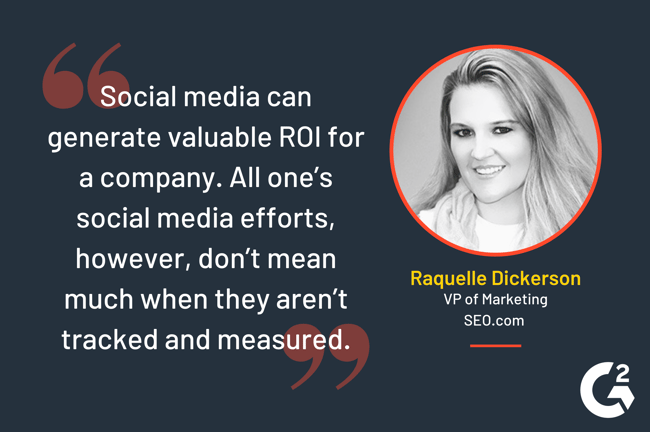April 17, 2019
 by Devin Pickell / April 17, 2019
by Devin Pickell / April 17, 2019

Social media stands alone as one of the most powerful marketing mediums to promote and distribute content today.
It’s free to use, easy to understand, and businesses of any size can include it as one of their key digital marketing pillars.
But once you acquire a sizable following on platforms like Twitter, Facebook, and Instagram, it’s essential to analyze all the activity going on with your brand.
Using social media analytics software, you can uncover a variety of insights. For example, being able to measure what users say about your brand through social media monitoring. With more advanced tools like social listening, you’re able to capture brand sentiment and which topics are trending on social media and throughout the web.
To get the most out of these tools and to acquire new strategies, we asked six social media and analytics experts for their tips for fellow brands. Here’s what they had to say.
See a tip you like? Feel free to jump ahead.
Raquelle Dickerson, VP of Marketing at SEO.com
This may be an obvious one, but with hundreds of social media tools out there today, it’s actually more difficult than it seems. Let’s hear what Raquelle had to say.
“A brand’s social media interactions are important. It is more than just posting a fun tweet or image on Instagram. Social media can generate valuable ROI for a company. Your social media efforts, however, don’t mean much when they aren’t tracked and measured. Like SEO analytics for website search rankings, there is also analytics for social media.
The number of social media analytics tools out there is overwhelming. For those just starting out on social media analytics, I would recommend doing some research on what social media platforms your customers are most active on. Knowing the social media channels you need to be on will help narrow down the social media analytics platforms that would be best for your business.”
Great insight from Raquelle, particularly touching on the importance of meeting your users on the right platforms. For example, if 80 percent of your followers are on Twitter, it wouldn’t make sense to license a tool used mainly for Instagram.
 If you need help narrowing down your social media tool results, see what our complete category on social media management software may offer. You can filter results to fit your needs as a company.
If you need help narrowing down your social media tool results, see what our complete category on social media management software may offer. You can filter results to fit your needs as a company.
Audrey Strasenburgh, SEO Strategist at LogoMaker
The term “native” in tech typically refers to something in its natural environment. When it comes to social media, native analytics will reside in the platform itself. Audrey explains this a bit more.
“When it comes to social media analytics and trying to see how effective your campaign is, you are going to want to look at each social media profile's analytics tool. These may include Facebook Insights, Twitter Analytics, Instagram Analytics, YouTube Analytics, and others.
These reporting dashboards will show you key data such as which posts received the most interaction, the best time to post based on your audience, who your audience is and what your target demographic should be, number of followers, and more.
Use this feedback to improve your social media posting strategy. This data is also crucial if you plan to implement a paid social media marketing campaign in the future as you want to make sure your money is put to good use and drives conversions.”
Native social analytics can be useful for companies just getting started on social media. They’re a feasible, entry-level option for companies who don’t quite have the budget yet to commit to a social media tool.
Marie Lamonde, Content Marketing Specialist at DashThis
Your first priority on social media should be to put effort into building a following and a regular content schedule. After this, you’ll need to begin tracking the results from these efforts. Here’s what Marie says about tracking.
“It might take some time before you see valuable results, this is why you should track your data through time: month over month, year over year. Making sure the numbers are constantly improving, and don't get lost in vanity metrics, make sure you track only the data that is relevant for your company.
If you use social media to get more traffic (and clients) on your website, don't waste time tracking your likes and retweets, you'll want to track KPIs such as referral traffic, conversions, and traffic by channel. By tracking the right data you will be able to know if a social media strategy, type of content, or platform does or does not work for your brand. Therefore, you'll be able to adapt your efforts and reach your goals.”
Marie is spot on. Vanity metrics like comments, mentions, and retweets are useful on the surface but don’t contribute much to longer-term strategies.
Alexandra Zelenko, Marketing and Technical Writer at DDI Development
No two social media marketing campaigns will show the same picture, which is why it’s important to determine the right metrics ahead of time. Doing so will help you measure the campaign’s progress easier and with greater focus. Here’s Alexandra’s take on social media metrics for campaigns.
“A recent study of 344 social media marketers revealed that the most important metrics for tracking the success of social media are engagement (36%) and conversion rates (35%). When planning a social media campaign, you should choose a specific goal for a defined period of time. Be sure that your goals are “S.M.A.R.T.”: specific, measurable, attainable, realistic and time-bound. For instance, if you’re looking to improve brand awareness, you might set a goal of 500 likes or 100 shares. In this case, you might track metrics such as likes, shares, net followers, and engagement.”
For more insight on key performance indicators and how brands determine them, check out this simple guide from our research team.
Amandine Henrard, Head of Acquisition at Upfluence
Social media is free and easy-to-use, which could actually be a blessing and a curse. On one side, it’s a simple way to put your brand out there. On the other, this means millions of brands are vying for users’ attention. Let’s hear Amandine’s solution to this.
“Be sure to retarget visitors for higher conversion rates. Social media users aren’t actively looking for your product, which makes them harder to convert (even if they have related interests). To overcome this obstacle, target users who have already visited your website or interacted with your content. Whether by AdWords, Facebook Business Manager, LinkedIn, or another analytics tool, retargeting audiences allows you to reach profiles who are more likely to convert.”
Being transparent with who your target audiences are will definitely lead to higher conversion rates. Don’t aim to serve everyone, this isn’t a realistic goal.
If you need more clarity on what exactly retargeting is, check out our five-minute guide.
Binu Francis, Marketing and Business Strategist at Shoppr
The final insight is essentially how brands consider their next steps through the use of analytics. This is the simplest way to define “data-driven.” I’ll let Binu explain in further detail how data influences decisions on social media.
“It's really important to align actions with analytics, as analytics won't do that for you. Your next set of actionables on social media need to be driven by whatever goals you established. Every time you check a report, see if you've gotten better over time, not just in terms of engagement, but also conversions.
A platform like Facebook also allows you to add competing pages so you can see how well they're doing and how you compare against them. Experiment with the kinds of content you share, stick to what earns you the best results and keep improving from there. It’s at this point where analytics really help – validating what's working and how well it's working, through quantifiable data.”
Following our intuition is great, especially if you’re a seasoned social media marketer or analyst. But validating processes with analytics is even better, and helps when it comes time to show value to your manager or stakeholders.
Thanks again to all our contributors for their insights on what’s worked for them on social media, how they were able to analyze it, and how they put analysis to action.
Are you researching stats and trends pertaining to social media? We compiled a one-stop hub with 80 social media statistics on platforms like Facebook, Twitter, YouTube, and others.
Care to share your insight on topics like this one? Join our network of contributors and reach more than 1 million visitors to the G2 Learn Hub.
Devin is a former senior content specialist at G2. Prior to G2, he helped scale early-stage startups out of Chicago's booming tech scene. Outside of work, he enjoys watching his beloved Cubs, playing baseball, and gaming. (he/him/his)
Are you a marketer looking for more ways to capture and analyze the many ways users interact...
 by Devin Pickell
by Devin Pickell
In the time it takes to read this sentence, tens of thousands more tweets will have been...
 by G2 Staff
by G2 Staff
The more data we collect about our marketing activities, the more doors can open to lead us to...
 by Daniella Alscher
by Daniella Alscher
Are you a marketer looking for more ways to capture and analyze the many ways users interact...
 by Devin Pickell
by Devin Pickell
In the time it takes to read this sentence, tens of thousands more tweets will have been...
 by G2 Staff
by G2 Staff


